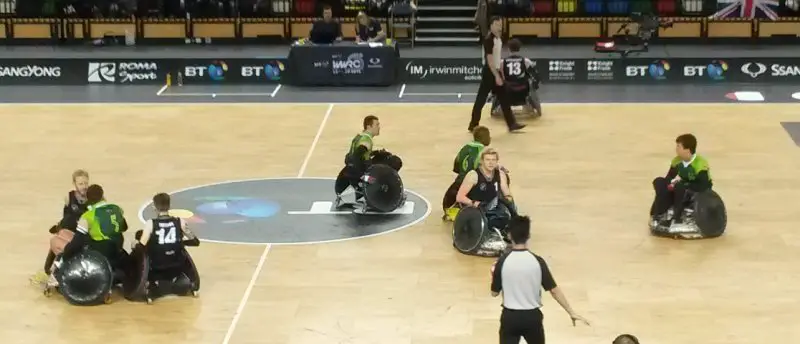
Rugby World Cup: accessible Olympic Park
Rugby is most certainly the sport of the moment with the World Wheelchair Rugby Challenge having run alongside the Rugby World Cup. Emma Crees tells us about her experiences of watching a recent World Wheelchair Rugby Challenge at the Olympic Park and, scroll down the page to watch Co-editor Martyn’s accessibility video guide to getting to the venue.
This past week, 12th to the 16th October, the first ever World Wheelchair Rugby Challenge took place at the Copper Box in the Queen Elizabeth Olympic Park. Eight teams took part, including the South African WheelBoks, who are currently ranked number 17 in the world, and the number 1 team from Australia, the Steelers.
Wheelchair rugby is the one disability sport I had always wanted to see but hadn’t yet had a chance to. So to go and watch the matches that would settle the minor places in the tournament was really exciting.
My friend and I travelled to London the day before to visit another friend who lives there. We then stayed in a hotel overnight and got the DLR over to Stratford International before heading over to the Copper Box, which is within the Olympic Park.
We did have to change DLR trains, but it was really easy to do so because all of the DLR has step–free access. Of course the step-free access does only work as long as the lifts do. But I was pleased to see that they had clear and frequent messages on the departure board listing the station/platform that had a problem. Luckily none of the stations we were using were affected.
First up was the match for 7th and 8th places, which was played between South Africa and New Zealand. That started with the NZ team doing the Haka – very cool to watch.
I had been expecting this to be a male sport, but it was actually mixed, although the majority of the players we saw were male.
It is certainly very is fast and furious and quite rough. I knew it had originally been called Murderball and watching the players ram each other with their wheelchairs proved why it was. In fact, hitting an opponent’s wheelchair is allowed, as long as it’s not behind the rear axle. Hitting a person is not allowed though.
The frequent crashes were loud and spectacular to watch, but made me glad I wasn’t on the pitch playing. I’m really not sure how the players can take the knocks they do and get picked up by their coaches and keep going.
The South African team is quite new to wheelchair rugby and, whilst the players gave a valiant effort and clearly enjoyed playing, they lost this match, just as they did every other match they played in the tournament.
New Zealand really had them outclassed and ended up setting the record for number of tries in a single match in the tournament. The final score was New Zealand 76 and 29 South Africa, meaning New Zealand took the 7th place overall and South Africa the 8th.
After a very short break (less than 10 minutes) the British and French teams came out to warm up for their match. Those teams seemed much more evenly matched, which made the game quicker.
One of the things that we saw frequently, especially during this match, was players having to have their wheels changed because of damage to them during play. This is done with the player still in their chair and still on the court. The French team had someone on the side lines who seemed to be permanently changing inner tubes and pumping up tyres to keep up with demand.
Finally after an exciting game it came to an end with a final score of Great Britain 53 and 49 France, leaving Team GB in the 5th place and France in the 6th.
The Copper Box was very empty, which was disappointing to see. But we were sat near a school party and so what the arena lacked in bums on seats was more than made up for with the energy and enthusiasm of those kids as they cheered and chanted for their team of choice.
When it was time to go I grabbed something to eat and then wheeled through the centre, this time to Stratford station where I picked up the Jubilee line back to Waterloo and my train back home.
The tube isn’t quite as easy as the DLR for access as only certain stations have access. You also need to be careful about how and where you board a train to be sure you get access at your destination.
Although this is clearly marked on the floor at Stratford with big blue wheelchair symbols and ‘board here for level access at Green Park’ signs, it’s not at every station.
Both Stratford and Waterloo have total step-free access, so I didn’t need to worry about that. It was very crowded by this point as the rugby had finished and it was going into rush hour, so it was hard to fight my way through in places. I was glad to arrive at Waterloo and have a member of staff assist me through the station and onto the train as that made the crowd much easier.
The whole day was great and left me wondering: when might I get to watch the rugby again. I’d really love to, and I hope more people will too.
Video guide: accessible transport to the Olympic Park
By Emma Crees
Follow Emma on Twitter @FunkyFairy22 or visit her blog, www.writerinawheelchair.co.uk.
If you’re planning on staying in London for any rugby matches, why not take a look at our travel site, Accomable, where you can find accessible accommodation in London, the rest of the UK and across the world?
You can also get in touch by messaging us on Facebook, tweeting us @DHorizons, emailing us at editor@disabilityhorizons.com or leaving your comments below.
